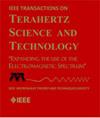降雪对太赫兹通道性能的影响:测量和建模启示
IF 3.9
2区 工程技术
Q2 ENGINEERING, ELECTRICAL & ELECTRONIC
IEEE Transactions on Terahertz Science and Technology
Pub Date : 2024-06-21
DOI:10.1109/TTHZ.2024.3417319
引用次数: 0
摘要
在不断发展的无线通信领域,对 0.1-10 太赫兹(THz)频谱的研究已成为推进超高速数据传输技术的关键重点。太赫兹无线通信技术的有效部署要求对各种大气条件下的信道性能进行全面研究,如雨、雾、云、霾,尤其是雪。这些环境因素对协议栈的设计,从物理层信号处理到应用设计和战略网络规划都有重大影响。深入了解现实世界环境中的信道传播和衰落特性,尤其是超宽带宽的信道传播和衰落特性至关重要。本研究对雪地环境中的视距线(LoS)太赫兹信道性能进行了全面的测量和理论研究。它有条不紊地研究了信道功率和误码率 (BER) 的经验和预测方面。分析并讨论了降雪率、载波频率、环境温度和相对湿度对信道性能的影响。我们的研究结果表明,降雪条件不仅会造成功率损失,还会引起太赫兹信道功率水平的快速波动。值得注意的是,我们的结果表明在这些情况下没有明显的多径效应。这一见解强调了进一步研究雪花运动动态及其与太赫兹传输路径相互作用的必要性。本文章由计算机程序翻译,如有差异,请以英文原文为准。
Impact of Snowfall on Terahertz Channel Performance: Measurement and Modeling Insights
In the evolving domain of wireless communication, the investigation of the terahertz (THz) frequency spectrum, spanning 0.1–10 THz, has become a critical focus for advancing ultra-high-speed data transmission technologies. The effective deployment of THz wireless communication techniques mandates a complete study of channel performance under various atmospheric conditions, such as rain, fog, cloud, haze, and, notably snow. These environmental elements significantly impact the design of the protocol stack, ranging from physical-layer signal processing to application design and strategic network planning. An in-depth understanding of channel propagation and fading characteristics in real-world environments, especially over ultrawide bandwidths, is crucial. This work presents a comprehensive measurement-based and theoretical investigation of Line-of-Sight (LoS) THz channel performance in snowy conditions. It methodically examines both the empirical and predicted aspects of channel power and bit-error-ratio (BER). The effects of snowfall rate, carrier frequency, ambient temperature, and relative humidity on channel performance are analyzed and discussed. Our findings demonstrate that snowy conditions not only exert power loss but also induce rapid fluctuations in the power levels of the THz channel. Notably, our results reveal an absence of significant multipath effects in these scenarios. This insight highlights the need for further research into the dynamics of snowflake movement and their interaction with THz transmission paths.
求助全文
通过发布文献求助,成功后即可免费获取论文全文。
去求助
来源期刊

IEEE Transactions on Terahertz Science and Technology
ENGINEERING, ELECTRICAL & ELECTRONIC-OPTICS
CiteScore
7.10
自引率
9.40%
发文量
102
期刊介绍:
IEEE Transactions on Terahertz Science and Technology focuses on original research on Terahertz theory, techniques, and applications as they relate to components, devices, circuits, and systems involving the generation, transmission, and detection of Terahertz waves.
 求助内容:
求助内容: 应助结果提醒方式:
应助结果提醒方式:


